Acromegaly Case Study Analysis: Health and Homeostasis 91562
VerifiedAdded on 2023/06/11
|6
|1329
|257
Case Study
AI Summary
This case study provides an analysis of acromegaly, a disorder resulting from excess growth hormones, primarily examining its symptoms, signs, and underlying causes. The analysis identifies symptoms such as amenorrhea, increased body size, fatigue, breathing difficulties, and poor sleeping patterns, correlating them with physical signs like coarsened facial features, spade-like hands and feet, and galactorrhea. The study explains that acromegaly affects multiple body systems, including cardiovascular, pulmonary, and musculoskeletal systems, leading to conditions like hypertension, congestive heart failure, and obstructive sleep apnea. It further elaborates on the role of the pituitary gland and hormonal imbalances, particularly the overproduction of growth hormones due to benign tumors, and their effects on insulin-like growth factor I (IGF-I) levels. The analysis concludes by referencing various studies that highlight the potential complications of elevated IGF-I levels, such as diabetes, heart disease, and high blood pressure, providing a comprehensive understanding of acromegaly's pathogenesis and clinical manifestations.
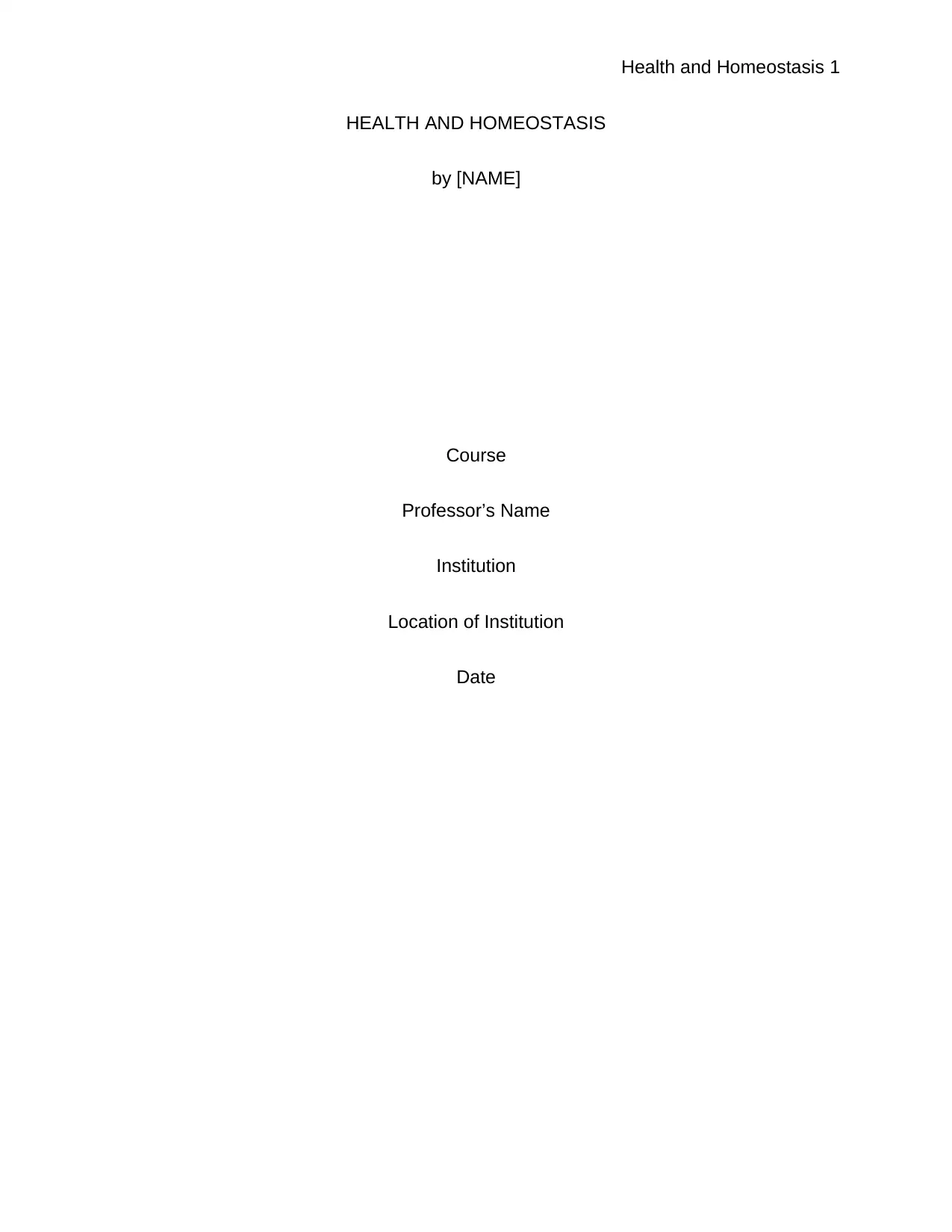
Health and Homeostasis 1
HEALTH AND HOMEOSTASIS
by [NAME]
Course
Professor’s Name
Institution
Location of Institution
Date
HEALTH AND HOMEOSTASIS
by [NAME]
Course
Professor’s Name
Institution
Location of Institution
Date
Paraphrase This Document
Need a fresh take? Get an instant paraphrase of this document with our AI Paraphraser
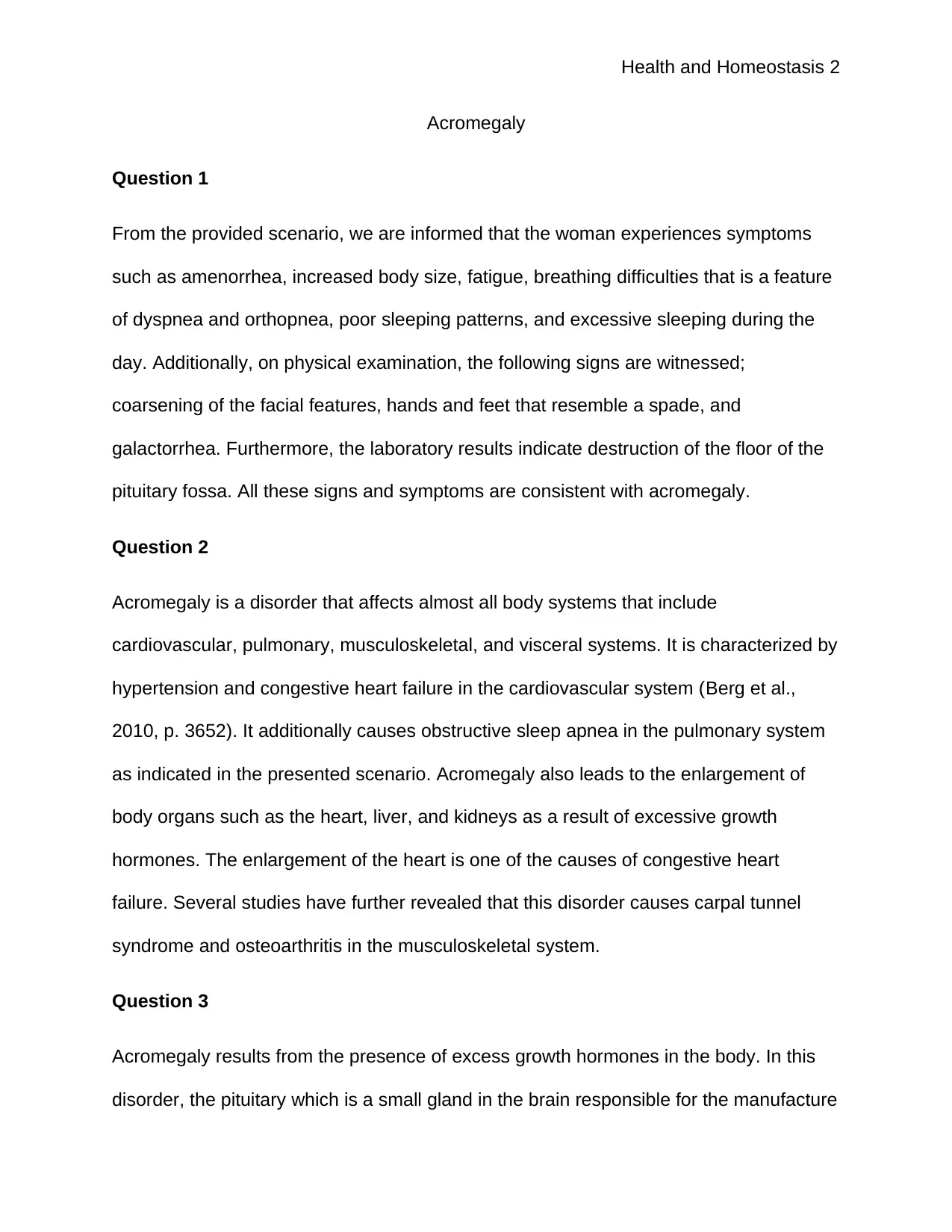
Health and Homeostasis 2
Acromegaly
Question 1
From the provided scenario, we are informed that the woman experiences symptoms
such as amenorrhea, increased body size, fatigue, breathing difficulties that is a feature
of dyspnea and orthopnea, poor sleeping patterns, and excessive sleeping during the
day. Additionally, on physical examination, the following signs are witnessed;
coarsening of the facial features, hands and feet that resemble a spade, and
galactorrhea. Furthermore, the laboratory results indicate destruction of the floor of the
pituitary fossa. All these signs and symptoms are consistent with acromegaly.
Question 2
Acromegaly is a disorder that affects almost all body systems that include
cardiovascular, pulmonary, musculoskeletal, and visceral systems. It is characterized by
hypertension and congestive heart failure in the cardiovascular system (Berg et al.,
2010, p. 3652). It additionally causes obstructive sleep apnea in the pulmonary system
as indicated in the presented scenario. Acromegaly also leads to the enlargement of
body organs such as the heart, liver, and kidneys as a result of excessive growth
hormones. The enlargement of the heart is one of the causes of congestive heart
failure. Several studies have further revealed that this disorder causes carpal tunnel
syndrome and osteoarthritis in the musculoskeletal system.
Question 3
Acromegaly results from the presence of excess growth hormones in the body. In this
disorder, the pituitary which is a small gland in the brain responsible for the manufacture
Acromegaly
Question 1
From the provided scenario, we are informed that the woman experiences symptoms
such as amenorrhea, increased body size, fatigue, breathing difficulties that is a feature
of dyspnea and orthopnea, poor sleeping patterns, and excessive sleeping during the
day. Additionally, on physical examination, the following signs are witnessed;
coarsening of the facial features, hands and feet that resemble a spade, and
galactorrhea. Furthermore, the laboratory results indicate destruction of the floor of the
pituitary fossa. All these signs and symptoms are consistent with acromegaly.
Question 2
Acromegaly is a disorder that affects almost all body systems that include
cardiovascular, pulmonary, musculoskeletal, and visceral systems. It is characterized by
hypertension and congestive heart failure in the cardiovascular system (Berg et al.,
2010, p. 3652). It additionally causes obstructive sleep apnea in the pulmonary system
as indicated in the presented scenario. Acromegaly also leads to the enlargement of
body organs such as the heart, liver, and kidneys as a result of excessive growth
hormones. The enlargement of the heart is one of the causes of congestive heart
failure. Several studies have further revealed that this disorder causes carpal tunnel
syndrome and osteoarthritis in the musculoskeletal system.
Question 3
Acromegaly results from the presence of excess growth hormones in the body. In this
disorder, the pituitary which is a small gland in the brain responsible for the manufacture
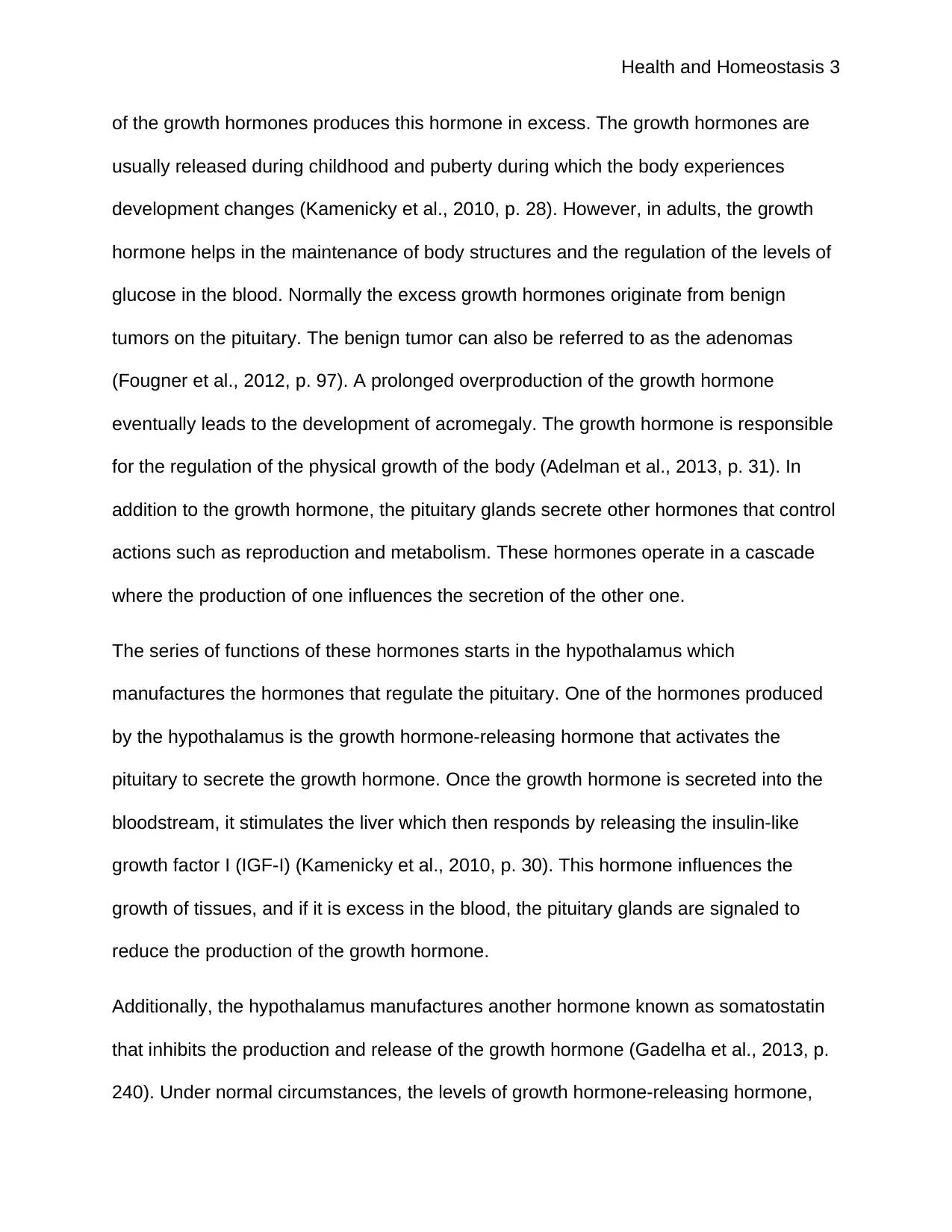
Health and Homeostasis 3
of the growth hormones produces this hormone in excess. The growth hormones are
usually released during childhood and puberty during which the body experiences
development changes (Kamenicky et al., 2010, p. 28). However, in adults, the growth
hormone helps in the maintenance of body structures and the regulation of the levels of
glucose in the blood. Normally the excess growth hormones originate from benign
tumors on the pituitary. The benign tumor can also be referred to as the adenomas
(Fougner et al., 2012, p. 97). A prolonged overproduction of the growth hormone
eventually leads to the development of acromegaly. The growth hormone is responsible
for the regulation of the physical growth of the body (Adelman et al., 2013, p. 31). In
addition to the growth hormone, the pituitary glands secrete other hormones that control
actions such as reproduction and metabolism. These hormones operate in a cascade
where the production of one influences the secretion of the other one.
The series of functions of these hormones starts in the hypothalamus which
manufactures the hormones that regulate the pituitary. One of the hormones produced
by the hypothalamus is the growth hormone-releasing hormone that activates the
pituitary to secrete the growth hormone. Once the growth hormone is secreted into the
bloodstream, it stimulates the liver which then responds by releasing the insulin-like
growth factor I (IGF-I) (Kamenicky et al., 2010, p. 30). This hormone influences the
growth of tissues, and if it is excess in the blood, the pituitary glands are signaled to
reduce the production of the growth hormone.
Additionally, the hypothalamus manufactures another hormone known as somatostatin
that inhibits the production and release of the growth hormone (Gadelha et al., 2013, p.
240). Under normal circumstances, the levels of growth hormone-releasing hormone,
of the growth hormones produces this hormone in excess. The growth hormones are
usually released during childhood and puberty during which the body experiences
development changes (Kamenicky et al., 2010, p. 28). However, in adults, the growth
hormone helps in the maintenance of body structures and the regulation of the levels of
glucose in the blood. Normally the excess growth hormones originate from benign
tumors on the pituitary. The benign tumor can also be referred to as the adenomas
(Fougner et al., 2012, p. 97). A prolonged overproduction of the growth hormone
eventually leads to the development of acromegaly. The growth hormone is responsible
for the regulation of the physical growth of the body (Adelman et al., 2013, p. 31). In
addition to the growth hormone, the pituitary glands secrete other hormones that control
actions such as reproduction and metabolism. These hormones operate in a cascade
where the production of one influences the secretion of the other one.
The series of functions of these hormones starts in the hypothalamus which
manufactures the hormones that regulate the pituitary. One of the hormones produced
by the hypothalamus is the growth hormone-releasing hormone that activates the
pituitary to secrete the growth hormone. Once the growth hormone is secreted into the
bloodstream, it stimulates the liver which then responds by releasing the insulin-like
growth factor I (IGF-I) (Kamenicky et al., 2010, p. 30). This hormone influences the
growth of tissues, and if it is excess in the blood, the pituitary glands are signaled to
reduce the production of the growth hormone.
Additionally, the hypothalamus manufactures another hormone known as somatostatin
that inhibits the production and release of the growth hormone (Gadelha et al., 2013, p.
240). Under normal circumstances, the levels of growth hormone-releasing hormone,
⊘ This is a preview!⊘
Do you want full access?
Subscribe today to unlock all pages.

Trusted by 1+ million students worldwide
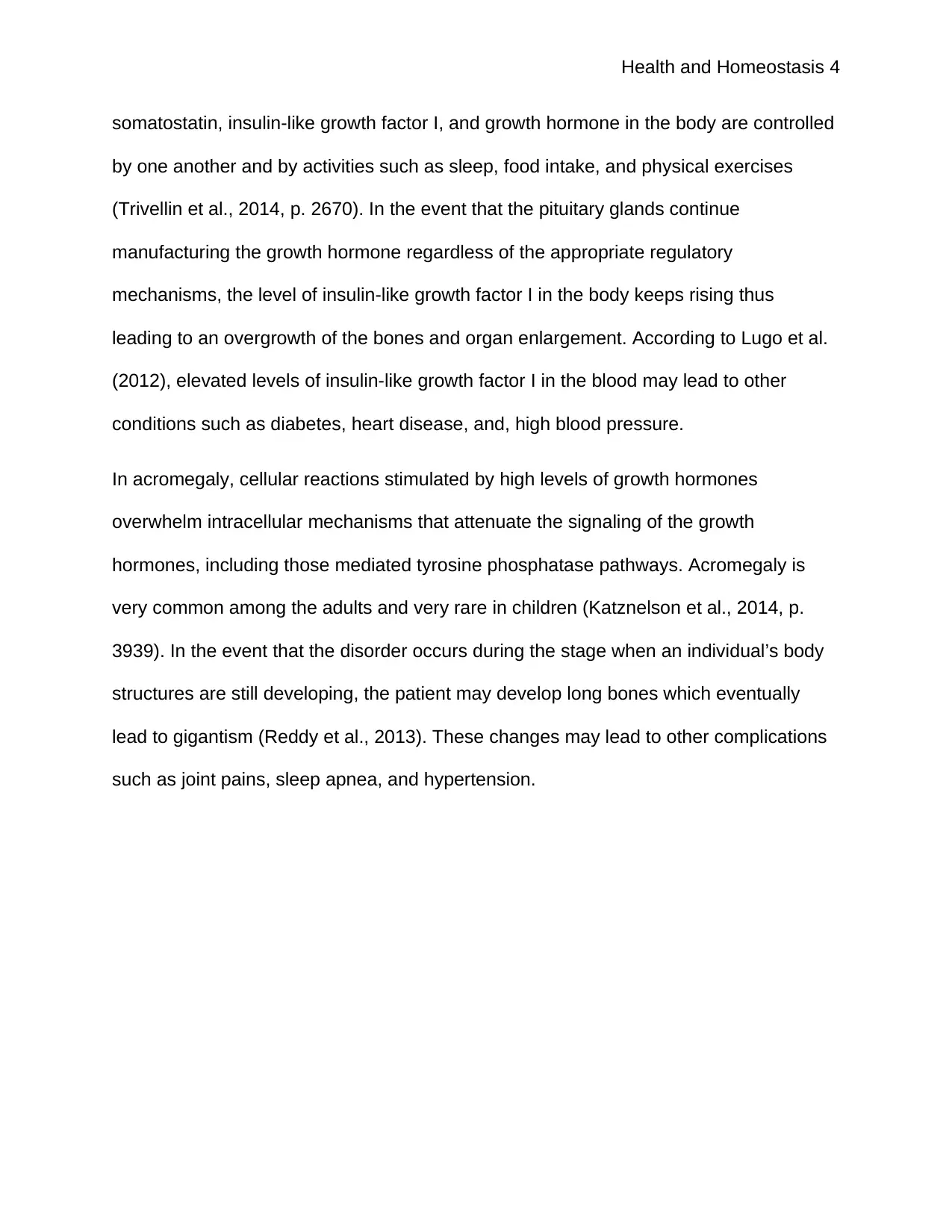
Health and Homeostasis 4
somatostatin, insulin-like growth factor I, and growth hormone in the body are controlled
by one another and by activities such as sleep, food intake, and physical exercises
(Trivellin et al., 2014, p. 2670). In the event that the pituitary glands continue
manufacturing the growth hormone regardless of the appropriate regulatory
mechanisms, the level of insulin-like growth factor I in the body keeps rising thus
leading to an overgrowth of the bones and organ enlargement. According to Lugo et al.
(2012), elevated levels of insulin-like growth factor I in the blood may lead to other
conditions such as diabetes, heart disease, and, high blood pressure.
In acromegaly, cellular reactions stimulated by high levels of growth hormones
overwhelm intracellular mechanisms that attenuate the signaling of the growth
hormones, including those mediated tyrosine phosphatase pathways. Acromegaly is
very common among the adults and very rare in children (Katznelson et al., 2014, p.
3939). In the event that the disorder occurs during the stage when an individual’s body
structures are still developing, the patient may develop long bones which eventually
lead to gigantism (Reddy et al., 2013). These changes may lead to other complications
such as joint pains, sleep apnea, and hypertension.
somatostatin, insulin-like growth factor I, and growth hormone in the body are controlled
by one another and by activities such as sleep, food intake, and physical exercises
(Trivellin et al., 2014, p. 2670). In the event that the pituitary glands continue
manufacturing the growth hormone regardless of the appropriate regulatory
mechanisms, the level of insulin-like growth factor I in the body keeps rising thus
leading to an overgrowth of the bones and organ enlargement. According to Lugo et al.
(2012), elevated levels of insulin-like growth factor I in the blood may lead to other
conditions such as diabetes, heart disease, and, high blood pressure.
In acromegaly, cellular reactions stimulated by high levels of growth hormones
overwhelm intracellular mechanisms that attenuate the signaling of the growth
hormones, including those mediated tyrosine phosphatase pathways. Acromegaly is
very common among the adults and very rare in children (Katznelson et al., 2014, p.
3939). In the event that the disorder occurs during the stage when an individual’s body
structures are still developing, the patient may develop long bones which eventually
lead to gigantism (Reddy et al., 2013). These changes may lead to other complications
such as joint pains, sleep apnea, and hypertension.
Paraphrase This Document
Need a fresh take? Get an instant paraphrase of this document with our AI Paraphraser
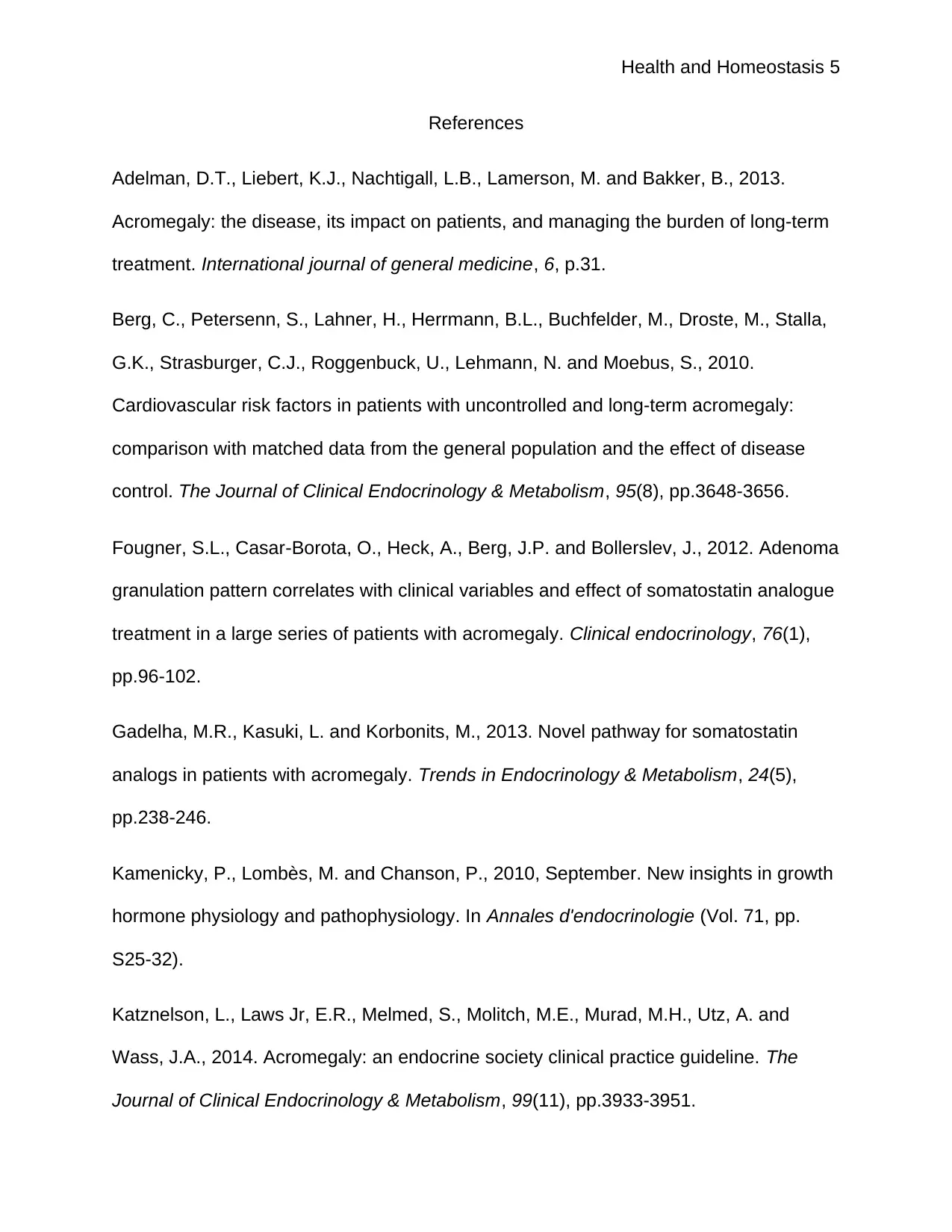
Health and Homeostasis 5
References
Adelman, D.T., Liebert, K.J., Nachtigall, L.B., Lamerson, M. and Bakker, B., 2013.
Acromegaly: the disease, its impact on patients, and managing the burden of long-term
treatment. International journal of general medicine, 6, p.31.
Berg, C., Petersenn, S., Lahner, H., Herrmann, B.L., Buchfelder, M., Droste, M., Stalla,
G.K., Strasburger, C.J., Roggenbuck, U., Lehmann, N. and Moebus, S., 2010.
Cardiovascular risk factors in patients with uncontrolled and long-term acromegaly:
comparison with matched data from the general population and the effect of disease
control. The Journal of Clinical Endocrinology & Metabolism, 95(8), pp.3648-3656.
Fougner, S.L., Casar‐Borota, O., Heck, A., Berg, J.P. and Bollerslev, J., 2012. Adenoma
granulation pattern correlates with clinical variables and effect of somatostatin analogue
treatment in a large series of patients with acromegaly. Clinical endocrinology, 76(1),
pp.96-102.
Gadelha, M.R., Kasuki, L. and Korbonits, M., 2013. Novel pathway for somatostatin
analogs in patients with acromegaly. Trends in Endocrinology & Metabolism, 24(5),
pp.238-246.
Kamenicky, P., Lombès, M. and Chanson, P., 2010, September. New insights in growth
hormone physiology and pathophysiology. In Annales d'endocrinologie (Vol. 71, pp.
S25-32).
Katznelson, L., Laws Jr, E.R., Melmed, S., Molitch, M.E., Murad, M.H., Utz, A. and
Wass, J.A., 2014. Acromegaly: an endocrine society clinical practice guideline. The
Journal of Clinical Endocrinology & Metabolism, 99(11), pp.3933-3951.
References
Adelman, D.T., Liebert, K.J., Nachtigall, L.B., Lamerson, M. and Bakker, B., 2013.
Acromegaly: the disease, its impact on patients, and managing the burden of long-term
treatment. International journal of general medicine, 6, p.31.
Berg, C., Petersenn, S., Lahner, H., Herrmann, B.L., Buchfelder, M., Droste, M., Stalla,
G.K., Strasburger, C.J., Roggenbuck, U., Lehmann, N. and Moebus, S., 2010.
Cardiovascular risk factors in patients with uncontrolled and long-term acromegaly:
comparison with matched data from the general population and the effect of disease
control. The Journal of Clinical Endocrinology & Metabolism, 95(8), pp.3648-3656.
Fougner, S.L., Casar‐Borota, O., Heck, A., Berg, J.P. and Bollerslev, J., 2012. Adenoma
granulation pattern correlates with clinical variables and effect of somatostatin analogue
treatment in a large series of patients with acromegaly. Clinical endocrinology, 76(1),
pp.96-102.
Gadelha, M.R., Kasuki, L. and Korbonits, M., 2013. Novel pathway for somatostatin
analogs in patients with acromegaly. Trends in Endocrinology & Metabolism, 24(5),
pp.238-246.
Kamenicky, P., Lombès, M. and Chanson, P., 2010, September. New insights in growth
hormone physiology and pathophysiology. In Annales d'endocrinologie (Vol. 71, pp.
S25-32).
Katznelson, L., Laws Jr, E.R., Melmed, S., Molitch, M.E., Murad, M.H., Utz, A. and
Wass, J.A., 2014. Acromegaly: an endocrine society clinical practice guideline. The
Journal of Clinical Endocrinology & Metabolism, 99(11), pp.3933-3951.

Health and Homeostasis 6
Lugo, G., Pena, L. and Cordido, F., 2012. Clinical manifestations and diagnosis of
acromegaly. International journal of endocrinology, 2012.
Reddy, R., Hope, S. and Wass, J., 2010. Acromegaly. BMJ: British Medical
Journal, 341.
Romijn, J.A., 2013. Acromegalic arthropathy: current perspectives.
Trivellin, G., Daly, A.F., Faucz, F.R., Yuan, B., Rostomyan, L., Larco, D.O.,
Schernthaner-Reiter, M.H., Szarek, E., Leal, L.F., Caberg, J.H. and Castermans, E.,
2014. Gigantism and acromegaly due to Xq26 microduplications and GPR101
mutation. New England Journal of Medicine, 371(25), pp.2363-2374.
Lugo, G., Pena, L. and Cordido, F., 2012. Clinical manifestations and diagnosis of
acromegaly. International journal of endocrinology, 2012.
Reddy, R., Hope, S. and Wass, J., 2010. Acromegaly. BMJ: British Medical
Journal, 341.
Romijn, J.A., 2013. Acromegalic arthropathy: current perspectives.
Trivellin, G., Daly, A.F., Faucz, F.R., Yuan, B., Rostomyan, L., Larco, D.O.,
Schernthaner-Reiter, M.H., Szarek, E., Leal, L.F., Caberg, J.H. and Castermans, E.,
2014. Gigantism and acromegaly due to Xq26 microduplications and GPR101
mutation. New England Journal of Medicine, 371(25), pp.2363-2374.
⊘ This is a preview!⊘
Do you want full access?
Subscribe today to unlock all pages.

Trusted by 1+ million students worldwide
1 out of 6
Related Documents
Your All-in-One AI-Powered Toolkit for Academic Success.
+13062052269
info@desklib.com
Available 24*7 on WhatsApp / Email
![[object Object]](/_next/static/media/star-bottom.7253800d.svg)
Unlock your academic potential
Copyright © 2020–2025 A2Z Services. All Rights Reserved. Developed and managed by ZUCOL.





